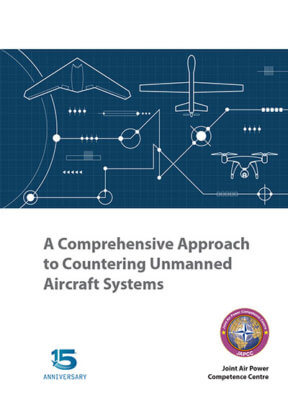Introduction
To define the impact of unmanned aerial systems on current and future NATO operations, it is very important to identify which kind or category of threats are included and which are not. This section will try to clarify this definition and will show that a clear classification is sometimes not easy to achieve.
A threat is typically defined as the combination of malevolent intent and the ability to put it into action. Further subcategories of this overarching term exist, such as ‘air threat’ to better describe the operational environment and to categorize or delineate measures, like ‘air defence’ to counter the respective threat. The set of all capabilities that qualify as air threats is so diverse and complex that no singular system can be used to execute air defence. Additionally, the question of what constitutes an air threat is not an easy one. Is an air threat any capability that uses the air as its main or final domain for effect delivery? If that were the case, a projectile from a rifle would be an air threat, which is not the case. However, the defence against larger projectiles like artillery shells or mortar rounds, which are a typical ground threat, finally became part of air defence considerations after Counter-Rocket-Artillery-Mortar (C-RAM) systems had been developed and fielded.
Defining Unmanned Aircraft
Since this document is about the threat of Unmanned Aircraft Systems (UAS), the term Unmanned Aircraft (UA) needs to be looked at. Currently, NATO defines UA as an aircraft that does not carry a human operator and which is operated remotely using various levels of automated functions.1 UA can be expendable or recoverable and may carry lethal or non-lethal payloads. Of note, cruise missiles are categorically excluded from this NATO definition. As this definition is very broad, the term aircraft needs to be described for a better understanding. The ICAO (International Civil Aviation Organization) defines an aircraft as any machine that can derive support in the atmosphere from the reactions of the air other than the reactions of the air against the earth’s surface.2
By this portrayal alone, all projectiles that only have initial propulsion and then just follow a ballistic trajectory (e.g. bullets, artillery shells, regular bombs or ballistic missiles) can be excluded from the aircraft category. For the purpose of this paper, also ordnance which uses aerodynamic lift or other interactions with the atmosphere just to extend the ballistic flight path will be excluded from the UA category as well. This removes threats like gliding bombs or hypersonic glide vehicles from the UA set, although they could be remotely operated and definitely possess automated functions. Emerging technologies (e.g. new propulsions, swarming or Artificial Intelligence) might create fringe threat sets, which generally show UA properties, but are currently not considered as such.
An extended definition proposal of Unmanned Aircraft (UA)
Vehicles that use aerostatic or aerodynamic lift, and overall don’t generally fly on a ballistic trajectory can be categorized as an aircraft. These vehicles can be propelled by a motor (e.g. rotary or jet) to create lift and sustain flight. If these aircraft do not house a pilot within the airframe and are operated remotely using various levels of automated functions, they are considered an UA, excluding cruise missiles.
Cruise Missiles versus Unmanned Aircraft
In general, making the distinction between ordnance and UA is not useful, due to tremendous technical progress. These two categories are not exclusive anymore, while not every ordnance is a UA, a UA can be used as ordnance. In times of mass production, innovative propulsion systems and reliable effect delivery without a pilot on board, the idea of using the vehicle as ordnance itself became more prevalent. While the V1 in WWII initially had a CEP (Circular Error Probable) of more than 10 km and most use cases were aimed at producing terror, today´s cruise missiles have a CEP of 10 meters or less. The cost/benefit ratio between losing the UA while creating a certain effect or enabling it to deliver the same effect while remaining retrievable has shifted significantly in times of precise technological options and relatively cheap production cost, especially for small UA.
Drone versus Unmanned Aircraft
The terms ‘Unmanned Aircraft’ and ‘Drone’, as well as variations such as ‘Unmanned Aerial Vehicle (UAV)’3 or ‘Remotely Piloted Aircraft (RPA)’4 are often used interchangeably but are actually deliberately defined to reflect certain classes, attributions or certifications of the unmanned systems.
When having to counter these systems, the most relevant factors are overall system complexity and aircraft size. Therefore, this book summarizes the different categories and classes of unmanned systems under the following two terms:
Unmanned Aircraft
The term ‘Unmanned Aircraft’ describes the overall set of vehicles, as described above. However, this book uses the term ‘UA’ to address military systems falling into the NATO Class II and III categories. UA are typically part of a complex system that can include dedicated Ground Control Stations, Mission Control Elements, multiple aircrews, military-grade communication systems, as well as dedicated infrastructure for logistics and maintenance. UA are usually operated by well-trained personnel, often qualified pilots, to safely operate alongside other airspace users. When addressing not only the aircraft but also other system components or the system as a whole, this book uses the term ‘Unmanned Aircraft System’ or ‘UAS’.
Drone
The term ‘drone’ is commonly used and widely accepted in the civil domain for all kinds of unmanned systems. Hence, this book uses the term ‘drone’ to address all types of consumer and commercial systems, which are generally smaller and less complex than their military counterparts. ‘Drone’ implies that the system is typically operated by a single, not necessarily qualified individual, from a handheld remote control, in relatively close proximity to the aircraft, and under Line-of-Sight (LOS) conditions. Therefore, this book also uses ‘drone’ for most military systems falling into the NATO Class I category, as their size and complexity is quite comparable to commercially available consumer models and therefore require a similar approach when having to counter them.













